For the last two months, the Australian labour market has gone backwards. The deterioration seems…
Australian labour market – deteriorating and approaching crisis
Today’s release of the – Labour Force data – for January 2015 by the Australian Bureau of Statistics shows that the Australian labour market contracted in January 2015, after the slight Xmas boost in December. Full-time employment growth was sharply negative and overall employment fell. Unemployment rose sharply and with the labour force growing at the rate of underlying population growth (participation rate steady), the unemployment rate shot up 0.3 points to 6.4 per cent. This is a disaster that has been unfolding for the last two years and now reflects the incompetent policy position of the current federal government. The Treasurer should now resign before he does any further damage. The broad ABS labour underutilisation rate – the sum of unemployment and underemployment – will now be heading towards 16 per cent (it is published in next month’s release). The teenage labour market went backwards again this month, which signals an urgent policy problem that the Federal government refuses to recognise or deal with. They are so obsessed with cutting fiscal deficits that they cannot see the future damage they are causing as a result of the appalling state of the youth labour market.
The summary ABS Labour Force (seasonally adjusted) estimates for January 2015 are:
- Employment decreased 12,200 (-0.1 per cent) with full-time employment decreasing 28,100 and part-time employment rising by 15,900.
- Unemployment increased 35,500 to 795,200.
- The official unemployment rate increased by 0.3 points to 6.4 per cent.
- The participation rate was steady at 64.8 per cent. It is still well below its November 2010 peak (recent) of 65.9 per cent.
- Aggregate monthly hours worked increased by 8.2 million hours (0.5 per cent).
- The last quarterly ABS broad labour underutilisation estimates (the sum of unemployment and underemployment) were updated last in November 2014. In that release, underemployment rose by 0.3 percentage points to 8.6 per cent and total labour underutilisation rate rose sharply to 15 per cent from 14.4 per cent in the August quarter. There were 1,070.7 thousand persons underemployed. With the rising unemployment since, the broad rate is now heading towards 16 per cent and over 2 million workers will be either unemployed or underemployed. The next quarterly release is in the February 2015 publication.
Employment growth negative – again
In the last month, total employment decreased by 12,200 -0.1 per cent) with full-time employment increasing by 28,100 and part-time employment rising by 15,900. Over the last 12 months employment has grown by only 1.6 per cent well which is still below the underlying population growth rate.
Over the last 24 months or so we have seen the labour market data switching back and forth regularly between negative employment growth and positive growth spikes.
The following graph shows the month by month growth in full-time (blue columns), part-time (grey columns) and total employment (green line) for the 24 months to January 2015 using seasonally adjusted data. It gives you a good impression of just how flat employment growth has been notwithstanding the huge spike in part-time employment in the August survey, which the revised data shows was substantially offset by the fall in full-time employment.
While full-time and part-time employment growth are fluctuating around the zero line, total employment growth is still well below the growth that was boosted by the fiscal-stimulus in the middle of 2010.
The following table provides an accounting summary of the labour market performance over the last six months. The monthly data is highly variable so this Table provides a longer view which allows for a better assessment of the trends. WAP is working age population (above 15 year olds).
The conclusion – overall there have been only 100.8 thousand jobs (net) added in Australia over the last six months. Full-time employment has risen by 53.8 thousand jobs (net) while part-time work has risen by 47 thousand jobs.
The Working Age Population has risen by 167 thousand in the same period while the labour force has risen by 114.1 thousand. The participation rate has edged up by 0.03 percentage points over the last six months.
The result is that employment growth has not been able to keep pace with the underlying population growth and unemployment has risen by 13 thousand.
To put the recent data in perspective, the following graph shows the movement in the labour force and total employment since the low-point unemployment rate month in the last cycle (February 2008) to January 2015. The two series are indexed to 100 at that month. The green line (right-axis) is the gap (plotted against the right-axis) between the two aggregates and measures the change in the unemployment rate since the low-point of the last cycle (when it stood at 4 per cent).
You can see that the labour force index has largely levelled off yet the divergence between it and employment growth has risen sharply (in spurts) over the last several months.
The Gap series gives you a good impression of the asymmetry in unemployment rate responses even when the economy experiences a mild downturn (such as the case in Australia). The unemployment rate jumps quickly but declines slowly.
It also highlights the fact that the recovery has not strong enough to bring the unemployment rate back down to its pre-crisis low. You can see clearly that the unemployment rate fell in late 2009 and then has hovered at the same level for some months before rising again over the last several months.
Since the current government was elected in September 2013, the situation has deteriorated significantly.
The Gap shows that the labour market is now in much worse shape than it was at the peak of the financial crisis in 2009. After the government prematurely terminated the fiscal stimulus the situation has progressively deteriorated.
In January 2015, the Gap of 2.8 percentage points and remains well above the levels that appeared in May and June 2009 when the Australian economy was enduring the impact of the crisis. All the gains made since then have thus disappeared due to poorly crafted fiscal policy not responding appropriately to non-government spending changes.
Today’s results continue to reflect an upward trend in the unemployment rate.
Full-time and Part-time employment in recovery
The following graph shows employment indexes for the last 3 recessions and allows us to see how the trajectory of total employment after each peak prior to the three major recessions in recent history: 1982, 1991 and 2009 (the latter to capture the current episode).
The peak is defined as the month of the low-point unemployment rate in the relevant cycle and total employment was indexed at 100 in each case and then indexed to that base for each of the months as the recession unfolded.
I have plotted the 3 episodes for 83 months after the low-point unemployment rate was reached in each cycle – the length of the current episode.
The initial employment decline was similar for the 1982 and 1991 recessions but the 1991 recovery was delayed by many month and the return to growth much slower than the 1982 recession.
The current episode is distinguished by the lack of a major slump in total employment, which reflects the success of the large fiscal stimulus in 2008 and 2009.
However, the recovery spawned by the stimulus clearly dissipated once the fiscal position was reversed and the economy is now producing very subdued employment outcomes.
Moreover, the current episode is also different to the last two major recessions in the sense that the recovery is over and the economy is deteriorating again.
The next 3-panel graph decomposes the previous graph into full-time and part-time employment. The vertical scales are common to allow a comparison between the three episodes.
First, after the peak is reached, part-time employment continues to increase as firms convert full-time jobs into fractional jobs.
Second, recoveries are dominated by growth in part-time employment as firms are reluctant to commit to more permanent arrangements with workers while there is uncertainty of the future course in aggregate demand.
Third, the current recovery is clearly mediocre by comparison, with both very subdued growth in full-time and part-time work.
Teenage labour market – continues to deteriorate
Teenagers lost 12.3 thousand jobs overall (net) in January 2015 – gaining 0.7 thousand full-time jobs and losing 13 thousand part-time jobs net.
The following graph shows the distribution of net employment creation in the last month by full-time/part-time status and age/gender category (15-19 year olds and the rest)
If you take a longer view you see how poor the situation remains.
Over the last 12 months, teenagers have lost 28 thousand jobs overall while the rest of the labour force have gained 213 thousand net jobs. Remember that the overall result represents a fairly poor annual growth in employment.
The teenage segment of the labour market is being particularly dragged down by the sluggish employment growth, which is hardly surprising given that the least experienced and/or most disadvantaged (those with disabilities etc) are rationed to the back of the queue by the employers.
The following graph shows the change in aggregates over the last 12 months.
To further emphasise the plight of our teenagers, I compiled the following graph that extends the time period from the February 2008, which was the month when the unemployment rate was at its low point in the last cycle, to the present month (January 2015). So it includes the period of downturn and then the so-called “recovery” period. Note the change in vertical scale compared to the previous two graphs.
Since February 2008, there have been only 1,021.1 thousand (net) jobs added to the Australian economy but teenagers have lost a staggering 121.7 thousand over the same period. It is even more stark when you consider that 112.7 thousand full-time teenager jobs have been lost in net terms.
Even in the traditionally, concentrated teenage segment – part-time employment, teenagers have gone backwards losing 9.1 thousand jobs (net) even though 584.2 thousand part-time jobs have been added overall.
Overall, the total employment increase is modest. Further, around 57 per cent of the total (net) jobs added since February 2008 have been part-time, which raises questions about the quality of work that is being generated overall.
To put the teenage employment situation in a scale context the following graph shows the Employment-Population ratios for males, females and total 15-19 year olds since February 2008 (the month which coincided with the low-point unemployment rate of the last cycle).
You can interpret this graph as depicting the loss of employment relative to the underlying population of each cohort. We would expect (at least) that this ratio should be constant if not rising somewhat (depending on school participation rates).
The facts are that the absolute loss of jobs reported above is depicting a disastrous situation for our teenagers. Males, in particular, have lost out severely as a result of the economy being deliberately stifled by austerity policy positions.
The male ratio has fallen by 9.7 percentage points since February 2008, the female by 6.8 percentage points and the overall teenage employment-population ratio has fallen by 9.6 percentage points. That is a staggering decline in the employment market for Australian teenagers.
Overall, the performance of the teenage labour market continues to be deeply disturbing. It doesn’t rate much priority in the policy debate, which is surprising given that this is our future workforce in an ageing population. Future productivity growth will determine whether the ageing population enjoys a higher standard of living than now or goes backwards.
The best the Government appears to be capable of is to dream up plans which deny income support to this group and impose impossible activity tests on them.
The longer-run consequences of this teenage “lock out” will be very damaging.
I continue to recommend that the Australian government immediately announce a major public sector job creation program aimed at employing all the unemployed 15-19 year olds, who are not in full-time education or a credible apprenticeship program.
The Government should abandon their ideological obsession with supply-side punishment regimes and realise that the unemployed cannot search for jobs that are not there.
It is clear that the Australian labour market continues to fail our 15-19 year olds. At a time when we keep emphasising the future challenges facing the nation in terms of an ageing population and rising dependency ratios the economy still fails to provide enough work (and on-the-job experience) for our teenagers who are our future workforce.
Unemployment – rose by 34,500
The unemployment rate rose by 0.3 points to 6.1 per cent in January 2015. Official unemployment rose 34,500 to 795,200.
Overall, the labour market still has significant excess capacity available in most areas and what growth there is is not making any major inroads into the idle pools of labour.
The following graph updates my 3-recessions graph which depicts how quickly the unemployment rose in Australia during each of the three major recessions in recent history: 1982, 1991 and 2009 (the latter to capture the 2008-2010 episode). The unemployment rate was indexed at 100 at its lowest rate before the recession in each case (January 1981; January 1989; May 2008, respectively) and then indexed to that base for each of the months as the recession unfolded.
I have plotted the 3 episodes for 83 months after the low-point unemployment rate was reached in each cycle. The current episode is now in its 82th month (0 being February 2008). For 1991, the peak unemployment which was achieved some 38 months after the downturn began and the resulting recovery was painfully slow. While the 1982 recession was severe the economy and the labour market was recovering by the 26th month. The pace of recovery for the 1982 once it began was faster than the recovery in the current period.
It is significant that the current situation while significantly less severe than the previous recessions is dragging on which is a reflection of the lack of private spending growth and declining public spending growth.
Moreover, the current episode is also different to the last two major recessions in the sense that the recovery is over and the economy is deteriorating again.
In relative terms, the current episode is now worse than the other two recessions (in terms of deviation from low-point unemployment rate).
The graph provides a graphical depiction of the speed at which the recession unfolded (which tells you something about each episode) and the length of time that the labour market deteriorated (expressed in terms of the unemployment rate).
Clearly this type of graph will lose relevance because the 1982 episode will start feeding into the 1992 period. It just goes to show how long these episodes of high unemployment are – in all three cases the unemployment rate was still well above where it started some 7 years earlier.
From the start of the downturn to the 84-month point (to January 2015), the official unemployment rate has risen from a base index value of 100 to a value 160.5. After falling steadily as the fiscal stimulus pushed growth along (it reached 122.5 after 35 months – in January 2010), it has been slowly trending up for some months now. Unlike the other episodes, the current trend, at this stage of the cycle, is upwards and accelerating.
It is now above the peak that was reached just before the introduction of the fiscal stimulus. In other words, the gains that emerged in the recovery as a result of the fiscal stimulus in 2009-10 have now been lost.
At 84 months, 1982 index stood at 137.7 (and falling) while the 1991 index was at 144.6 (and falling). It is clear that at an equivalent point in the “recovery cycle” the current period is more sluggish than our recent two major downturns and trending upwards while the trend in the earlier episodes was moderately downwards.
Note that these are index numbers and only tell us about the speed of decay rather than levels of unemployment. Clearly the 6.4 per cent at this stage of the downturn is lower that the unemployment rate was in the previous recessions at a comparable point in the cycle although we have to consider the broader measures of labour underutilisation (which include underemployment) before we draw any clear conclusions.
The notable aspect of the current situation is that the recovery is very slow.
Broad labour underutilisation
The ABS last published its quarterly broad labour underutilisation measures for the November quarter in last month’s release. The next release will be in the February 2015 data publication.
In the November-quarter, total underemployment rose from 7.6 per cent in August to 8.6 per cent and the ABS broad labour underutilisation rate (the sum of unemployment and underemployment) rose to 14.4 per cent to 15.0 per cent.
| There were 1,070.7 thousand persons underemployed. Overall, there were 1.848.1 million workers either unemployed or underemployed. |
If hidden unemployment is added to the broad ABS figure the best-case (conservative) scenario would see a underutilisation rate well above 17.5 per cent at present. Please read my blog – Australian labour underutilisation rate is at least 13.4 per cent – for more discussion on this point.
Aggregate participation rate – unchanged
The January 2015 participation rate was unchanged at 64.8 per cent. It remains substantially down on the most recent peak in November 2010 of 65.9 per cent when the labour market was still recovering courtesy of the fiscal stimulus.
What would the unemployment rate be if the participation rate was at that recent November 2010 peak level (65.9 per cent)?
The following graph tells us what would have happened if the participation rate had been constant over the period November 2010 to January 2015. The blue line is the official unemployment since its most recent low-point of 4 per cent in March 2008.
The red line starts at November 2010 (the peak participation month). It is computed by adding the workers that left the labour force as employment growth faltered (and the participation rate fell) back into the labour force and assuming they would have been unemployed. At present, this cohort is likely to comprise a component of the hidden unemployed (or discouraged workers).
Total official unemployment in January 2015 was estimated to be 795.2 thousand. However, if participation had not have fallen since November 2010, there would be 991.5 thousand workers unemployed given growth in population and employment since November 2010.
| The unemployment rate would now be 7.8 per cent if the participation had not fallen below its November 2010 peak of 65.9 per cent. |
The difference between the two numbers mostly reflects the change in hidden unemployment (discouraged workers) since November 2010. These workers would take a job immediately if offered one but have given up looking because there are not enough jobs and as a consequence the ABS classifies them as being Not in the Labour Force.
Note, the gap between the blue and red lines doesn’t sum to total hidden unemployment unless November 2010 was a full employment peak, which it clearly was not. The interpretation of the gap is that it shows the extra hidden unemployed since that time.
Hours worked – rose modestly in January 2015 but down over last year
Aggregate monthly hours worked increased by 8.2 million hours (0.5 per cent) in January 2015 in seasonally adjusted terms, after two consecutive month of decline.
The following graph shows the trend and seasonally adjusted aggregate hours worked indexed to 100 at the peak in February 2008 (which was the low-point unemployment rate in the previous cycle).
The next graph shows the monthly growth (in per cent) over the last 24 months. The dark linear line is a simple regression trend of the monthly change – which depicts as close to a zero trend as you will get. You can see the pattern of the change in working hours is also portrayed in the employment graph – zig-zagging across the zero growth line.
The reality is that working hours in the Australian labour market over the last two years have exhibited no net growth and over the last twelve months total working hours are down by 0.2 per cent.
Conclusion
In general, we always have to be careful interpreting month to month movements given the way the Labour Force Survey is constructed and implemented.
But today’s data shows that the labour market contracted in the month of January 2015 with employment falling and unemployment rising with a steady participation rate.
Employment growth remains well below the underlying population growth and total hours of work have contracted over the last year.
At the last release, the ABS Broad Labour Underutilisation rate – the sum of official unemployment and underemployment – was estimated to be 15 per cent. It is now edging up towards 16 per cent given today’s sharp rise in the unemployment rate (by 0.3 points to 6.4 per cent). That is a massive wastage rate and defies those who claim the economy is close to full employment.
The teenage labour market also remains in a parlous state. This is an emergency which is being ignored by the Federal Government.
The neglect of our teenagers will have a very long memory indeed and the negative consequences will be stronger given the ageing population.
The data continues to tell us that the policy settings are all wrong. A fiscal stimulus is urgently needed.
That is enough for today!
(c) Copyright 2015 William Mitchell. All Rights Reserved.
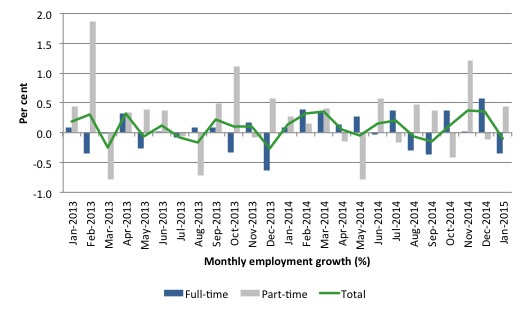
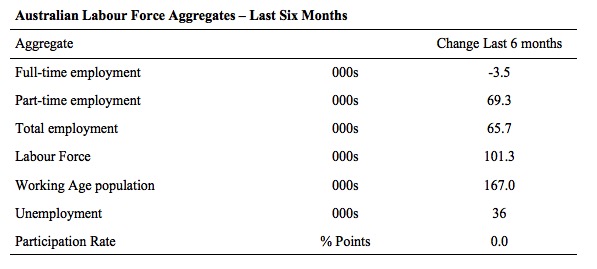
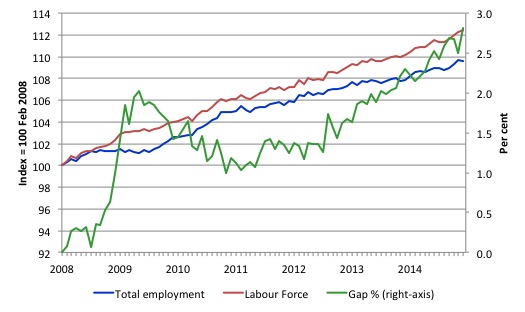
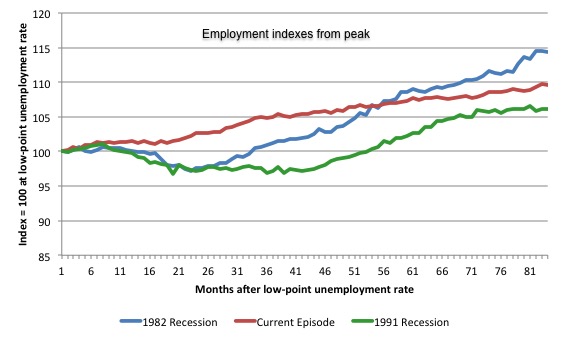

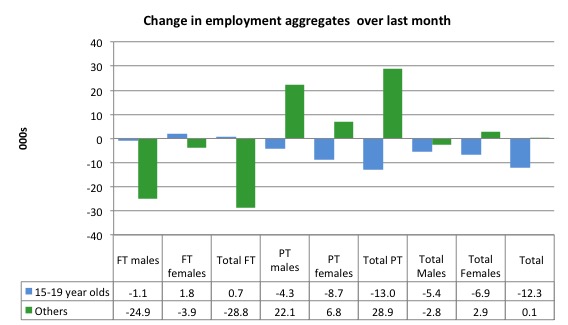
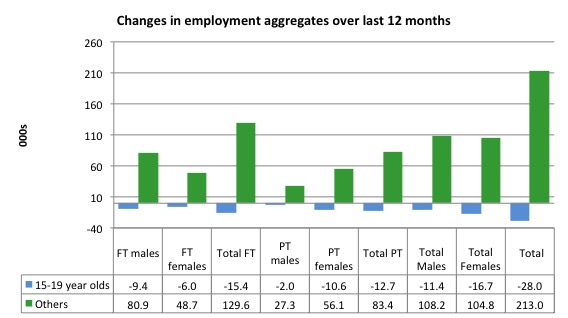
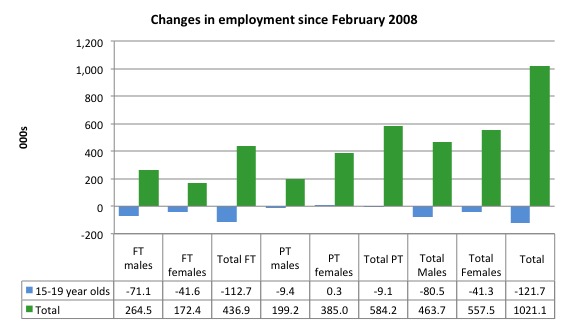
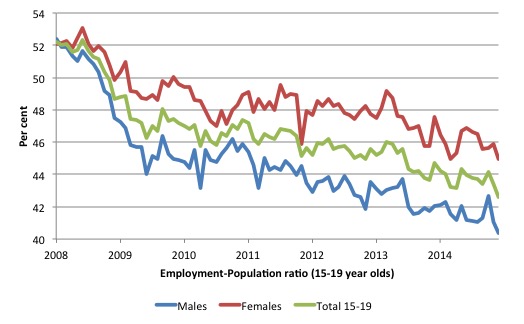
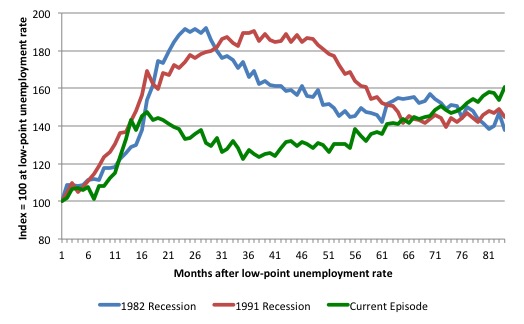
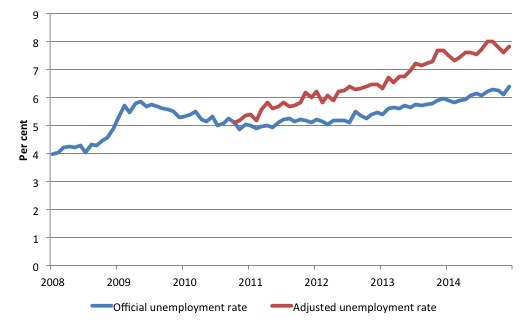
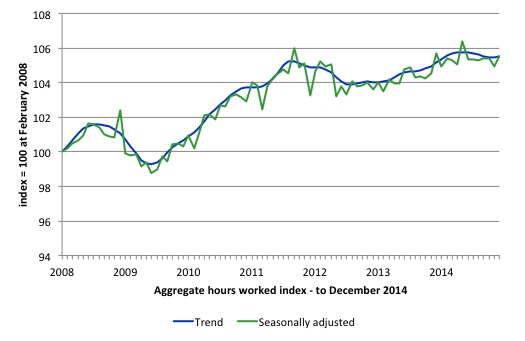
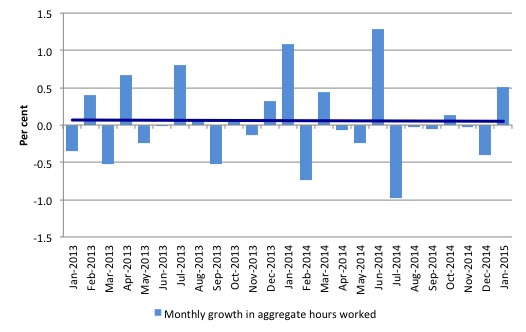
It seems that Treasurer Joe Hockey’s solution to the problem is to reduce spending and bring the budget back to surplus.
Not sure how that will work given the reduction in spending will lead to fall in income. But good luck to Joe Hockey in his final weeks as Treasurer,
The neo-liberals as epitomised by Joe Hockey keep parroting the usual line that deficits must be reduced, workers must be more flexible (code for reducing pay and conditions) and that with these measures will somehow, magically business will respond by creating many jobs.
Trouble is there’s not a skerrick of evidence that this works.
Please specify what exactly is causing “underlying population growth”.
Hint – it is not natural increase even with rubbish welfare like the baby bonus.
Hokey won’t resign. Even though these clowns call themselves “honourable” that quality is not in their character. Hokey and his partner in crime,Rabid Rabbott,will have to be sacked. That will happen but not soon enough.
What is causing population growth?
I imagine it’s a combination of birth rate, longer life expectancy and immigration. Why, is there a problem? Hint I wasn’t born in Australia.
Hockey and Abbot are the worst of a bad bunch, at least everyone knows they are cretins not to be trusted. Replacing them with more plausible goons with the same bad ideas doesn’t help.
Carlos Fandango = Ignorance is bliss
Podargus, why don’t you ever just come out and yell the immigrants are taking your job?
This is not a direct response to Bill’s Blog, today, except to the extent that the cause and fall-out from unemployment are universal, IMHO….
President Obama/Council of Economic Advisers:
We have an uneasy path going forward in how we address “unemployment”, and we don’t talk about our knotty dilemma, out loud…..when we should be having a frank discussion….
For instance, when every waking moment in capitalism is spent pondering how to eliminate as many of us humans, as possible, from the workplace, to increase profits [this is not an anti-profits statement-I am a capitalist—it is a statement of fact]….
But given this reality, why on earth would we put all our eggs in one basket-why would we look to the market to solve our unemployment crisis?
And compounding this, given “automation”, alone, the market is creating fewer and fewer jobs the further we advance into the 21st Century…..
For clarity, we should never condemn a CEO for closing a plant, when they are losing money, but we should be outraged by a non-response to “the importance of employment”–given this void in a market economy, and given the adverse consequences of unemployment?
And a large part of our blinders is the myth that “the market can provide anybody wanting a job, with a job”-it simply is not supported by the facts-to the detriment of the jobless, civility, and the market, to wit:
THE LAW OF DIMINISHED INCOME TO THE MARKET FROM UNEMPLOYMENT [hereafter the D/UE LAW]
Short Definition:
3% is the zero-sum threshold above which unemployment starts substantially undermining the Market–and the loss in income to the Market is compounded exponentially with each percentage point of increase in unemployment, above 3%.
Given the above, the frank discussion we should be having is about the distinct dichotomy we have going forward, in our job creation:
1] Are “employees” to be drawn from “A POOL OF SLAVES, To Be Used And Discarded “at will”, Amazon–[and while this language may sound inflammatory-it is, in reality, our current path] given the neo-liberal decimation of employee rights since WW II….
2] OR, do the adverse consequences of unemployment create a social obligation, on the part of the larger society, to create jobs-i.e., we acknowledge the obvious….that unemployment is a “social” problem-we have a solemn responsibility to address [and we have the “legal authorization”, on the books [15 USC § 3101], to restrict our jobless rate to 3%, tomorrow-see HR 1000, et al].
Ref: FULL EMPLOYMENT IS A PRO-MARKET CONCEPT, Amazon
Jim Green, Democrat opponent to Lamar Smith, Congress, 2000
It’s not just Abbott and Hockey that are revealed as clowns and economic illiterates — virtually all of the front bench of the government are tarred with the same brush. They are all mindlessly parroting Hockey’s line that the budget needs “repairing” (by which they mean the necessity to reduce the deficit and aim for a surplus). If you require evidence, just look at a range of recent interviews and speeches by George Brandis, Eric Abetz, Malcolm Turnbull, Christopher Pyne, Warren Truss, Barnaby Joyce, Scott Morrison, Kevin Andrews and Mathias Cormann.
Slightly off topic I’m afraid but I’ve just seen final confirmation from England, if any were needed, that the theory of trickle-down economics might not be quite as valid as some would claim.
A £514,000,000,000 TV deal to show domestic English football has just been completed by the 20 clubs of the English Premier League. Yet all but one, Chelsea, can’t guarantee their employees the living Wage of £7.85 an hour or £9.15 in London!
Maybe if it been slightly more? Say £600 billion?
I’m afraid my source for this missed out their decimal point and it was £5.14 billion not £514 billion! I thought that sounded a lot even for the EPL ! I should have checked instead of just copying it.
Still, that’s £257 million (I think!) per club so my point still stands!
In Australia things cannot possibly change whilst voters keep voting for the neoliberal duopoly of LNP and ALP. Both of our major parties serve only the rich owners of capital. Our current path leads to workers and the unemployed getting poorer and poorer. It also leads to climate change and limits to growth. This is all unsustainable long term. At some stage, voters have to abandon these dinosaur parties and vote for parties that will actually deal with the real problems.
Since people are less inclined these days to view politics through a left/right prism it might help to view matters through a brown/green prism. Either you are in favour of turning the world into a brown wasteland governed by a few super-rich people ruling over thralls in rags or you are in favour of a green, healthy world which can sustain a good economy and equality for all.
Something is different in the jobs lost.
In my world in Brisbane Australia we are seeing jobs lost from high paying jobs. Lots of engineers in the city and mine workers etc who have been getting 128K to 175K per year pay packets are going.
This is very very different to my experiences in the past. I wonder if anyone else has noticed. It was a trickle of high paid jobs lost last year but the trickle is quickly turning into a weekly stream now. If it keeps up it will be a river of high paid jobs lost within a month or so.
You cant rebalance this to Tourism jobs at $40,000pa. And building houses and highrise units (condos) for each other is short term employment. Once you build it the jobs gone. This does not look good to me.